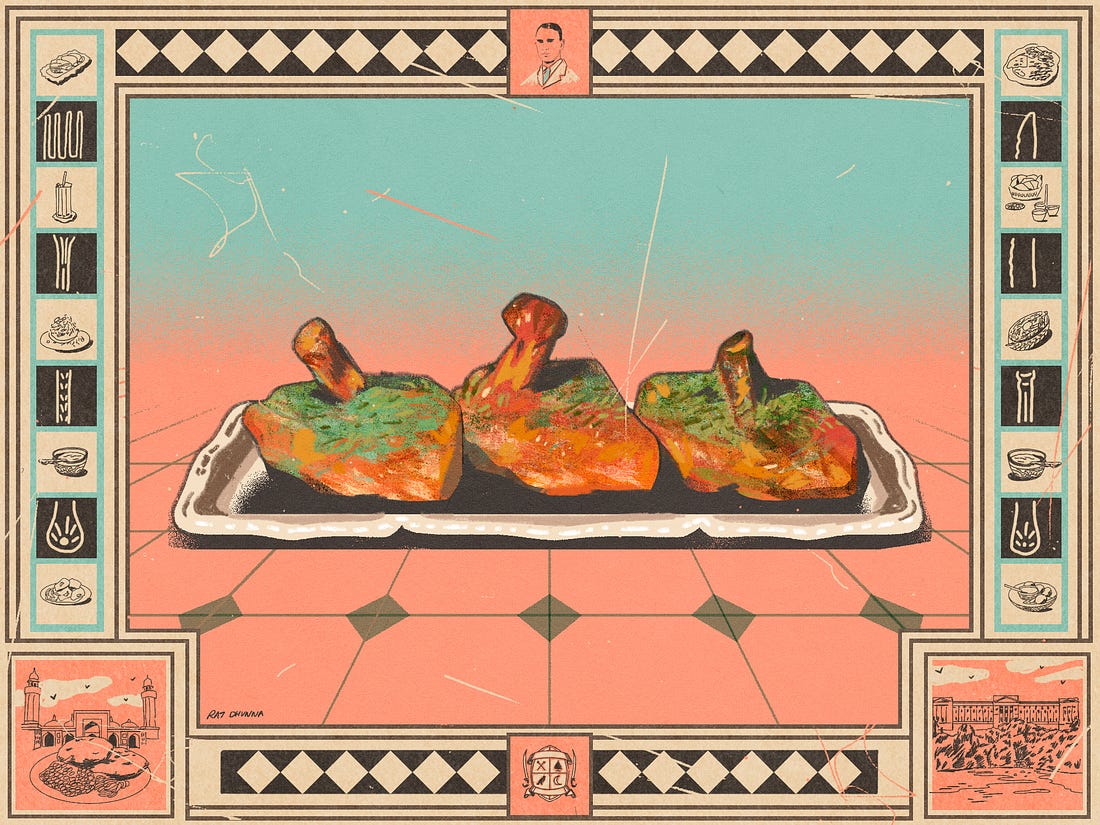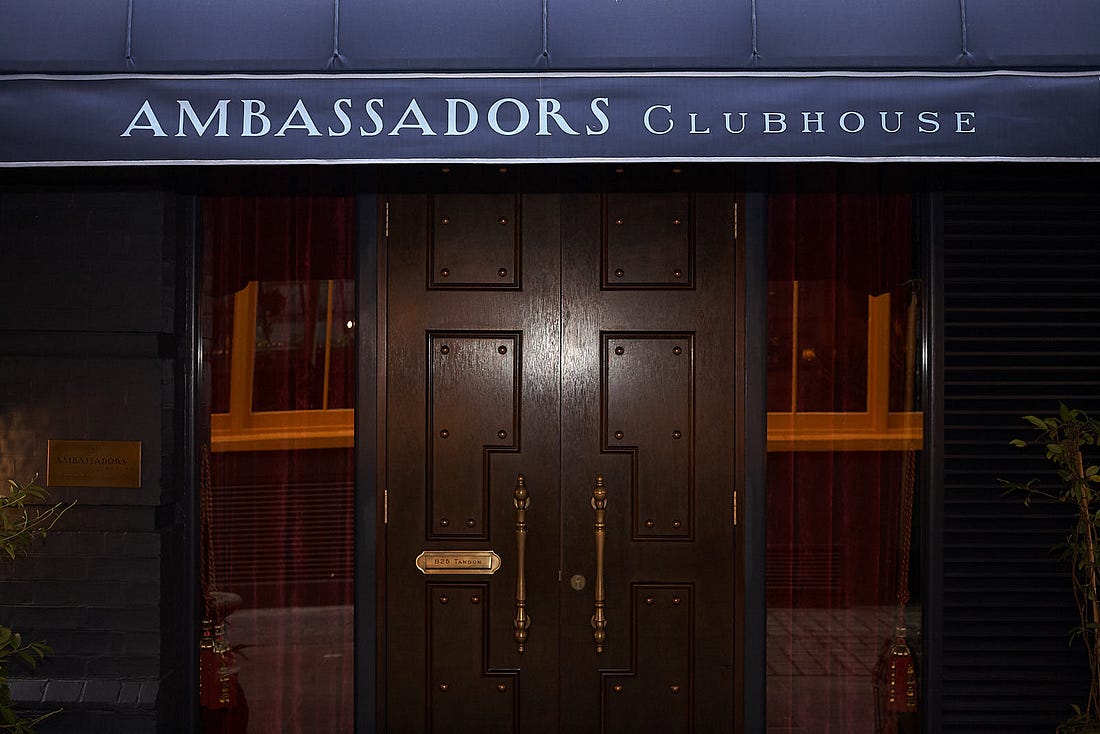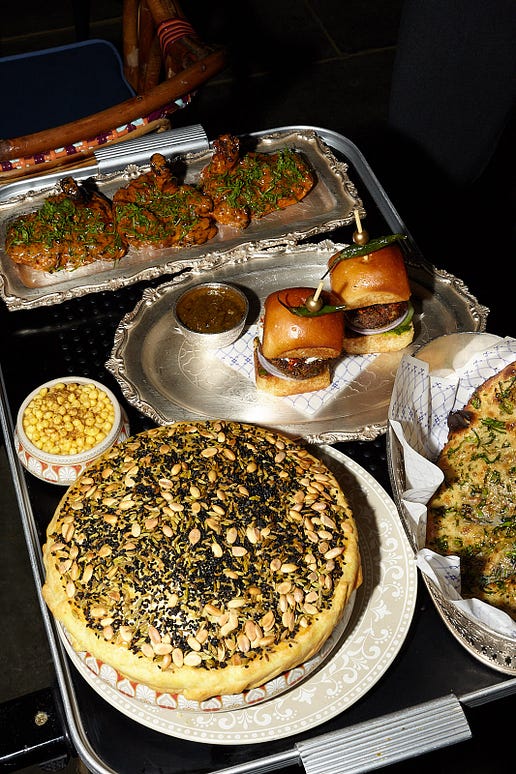Vittles Reviews: Three Meetings with the AmbassadorCiaran Thapar visits Ambassadors Clubhouse three times and contemplates the fantasy of an undivided Punjab. Illustration by Raj Dhunna. Photography by Michaël Protin.
In April 2023, the day before catching a flight to Pakistan with my wife Yasmin, I fielded two phone calls. One was from my thaiya – my dad’s eldest brother – who, citing our Indian heritage and the political instability surrounding Imran Khan’s recent arrest, tried to persuade me not to go. The other was from Yasmin’s mum, who was excited for our visit to Pakistan, where her parents had relocated (across the border, from their ancestral city of Jalandhar) at partition, before migrating to London in the late 1950s. But she was also unsure of how her relatives might react to me being from a Hindu family, so asked me not to mention it. After touching down at Lahore airport, we queued up to exit. The security officer flicking through my passport landed on the Indian visa from two months prior. He shone a small torch into my jetlagged eyes. Time – seventy-six years, to be exact – stood still. I felt a bead of sweat drip from my armpit – past the Hindi tattoo of cheesy old Bollywood lyrics which are scribed on my ribcage in memory of my late grandfather’s song-filled battle with dementia: ‘phir bhi dil hai Hindustani’ / ‘but my heart is Hindustani’. Then he snapped the passport shut, handed it back and smiled, ushering me through. We stayed with Yasmin’s cousin Noor and his wife Aleena. It turned out that Yasmin’s strict vegetarianism was more baffling to her family than me being half-Indian. On the contrary, my East Punjabi-ness became a badge of honour. When Noor told the elderly samose wala beside the Wazir Khan Mosque that my father was from Ludhiana, he let out a hoarse shriek of delight, throwing an extra handful of snacks into our folded newspaper. ‘Welcome home,’ Noor translated, chuckling. Through such interactions, I got a glimpse into the fantasy of an undivided Punjab – what it was like before 1947, and what it could be like now, if things had gone differently. With my mouth full of food – nihari spooned from a cauldron with a squeeze of lime; boti kebabs with fluffy naans and imli; street-side chicken biryani; drive-thru gol gappe and falooda; several outstanding karahis – I forgot about the phone calls. I forgot about the Radcliffe Line separating me from the Amritsari fried fish, aloo paronthe and saag with makki ki roti that I’d only recently been devouring a few kilometres to the east. Momentarily, I forgot about the notion – reinforced through years of participating in tense banter with other brown boys in the playground, watching cricket games in desi pubs and mistakenly defining my identity as distinct from my wife – that Charda Punjab and Lehnda Punjab were separated at all. A year later, I felt my eyebrows rise with equal parts skepticism and excitement when I was invited to the launch of Ambassadors Clubhouse, the restaurant from JKS which opened last August on Mayfair’s Heddon Street and which boldly claims to serve the food, drink, music and hospitality of an undivided Punjab. Few have dominated London’s contemporary South Asian fine dining scene more than siblings Jyotin, Karam and Sunaina Sethi, whose portfolio includes singular institutions Gymkhana, BiBi, Trishna and Brigadiers, plus the chain favourite Hoppers. If the plan was to eventually get me to write about their latest venture, given my writing on British Punjabi culture and my next book – a memoir about uncovering the legacy of Punjab’s partition in London – then I guess it worked. On the evening of Friday 16 August, within forty-eight hours of partition’s seventy-seventh anniversary, Yasmin and I were wedged between two other couples in the dazzling main room. The music was a playlist of trappy bhangra, 2000s Punjabi garage and desi rap, an extension of the club space in the basement (whose decks have been occupied by the likes of Panjabi MC, Yung Singh and Nitin Sawhney for a regular event series called AMBASSY, curated by fashion designer Sukhchain Singh Sohal). I love this power move, but it was so loud we couldn’t hear each other talk. As the waiter warmly explained the menu’s cross-border origins – all complimentary, in exchange for feedback – I wondered how other diners were making sense of the restaurant’s premise. Did they care about what ‘food from an undivided Punjab’ meant? Any more than Tim Hayward of the FT cared when he spent the first half of his review attacking the booking system rather than acknowledging anything about the regional specificity of the food being served to him? Any more than Giles Coren cared, closing the opening paragraph of his review in The Times with the line, ‘These days, if Esther and I fancy a curry, we get a Dishoom delivered and eat it in the kitchen with a middling shiraz like everyone else’? Any more than Eating With Tod – the man whose viral videos hum with the smug triumph of an East India Company captain writing home about the pillaging of another coastal settlement; the man who calls every South Asian restaurant he visits the ‘most authentic’ – cared?... Subscribe to Vittles to unlock the rest.Become a paying subscriber of Vittles to get access to this post and other subscriber-only content. A subscription gets you:
|




